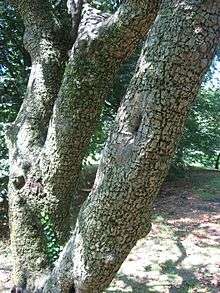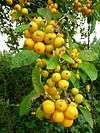Malus baccata
Malus baccata is an Asian species of apple known by the common names Siberian crab apple,[2] Siberian crab,[3] Manchurian crab apple and Chinese crab apple.[4][5][6] It is native to much of northern Asia, but is also grown elsewhere as an ornamental tree and for rootstock. It is used for bonsai. It bears plentiful fragrant white flowers and edible red to yellow fruit of about 1 cm diameter.
| Malus baccata | |
|---|---|
| Scientific classification | |
| Kingdom: | Plantae |
| Clade: | Tracheophytes |
| Clade: | Angiosperms |
| Clade: | Eudicots |
| Clade: | Rosids |
| Order: | Rosales |
| Family: | Rosaceae |
| Genus: | Malus |
| Species: | M. baccata |
| Binomial name | |
| Malus baccata | |
| Synonyms[1] | |
| |
Distribution and habitat
Malus baccata is native to Russia, Mongolia, China, Korea, Bhutan, India and Nepal,[4] where it is common to mixed forests on hilly slopes at elevations up to 1500 meters (5000 feet).[7] The tree is found in Japan,[6] and it has also been introduced to Europe and to North America, where it is found in the wild mostly in the Great Lakes Region and in the Northeastern United States.[8][9]
Features

Trees grow up to 10–14 meters (33–47 feet) high. They have arching or overhanging red-brown branches and red-brown buds. Petioles are 2–5 cm (0.8-2.0 inches) long, with few glands. Leaves are elliptic or egg-shaped, (3–8)×(2–3.5) cm ((1.2-3.2) × (0.8-1.4) inches). Pedicels are slender and 1.5–4 cm (0.5-1.6 inches) long. They bear white fragrant flowers of 3–3.5 cm (1.2-1.4 inches) in diameter which groups by 4–6. Petals are white and egg-shaped, approximately 2–2.5 cm (0.8-1.0 inches) long. Fruits are red to yellow and spherical, only about 1 cm (0.4 inches) in diameter; they form dense clusters and resemble cherries from a distance. Flowering occurs in spring, with fruits appearing in September–October.[7][5][6]
Subordinate taxa
The subordinate taxa include[4][7][6]
- Malus baccata var. baccata (10–14 meters tall) - China, Korea, Russia, Mongolia
- Malus baccata var. daochengensis
- Malus baccata var. gracilis (4–6 m) - Gansu + Shaanxi in China
- Malus baccata var. himalaica
- Malus baccata var. jinxianensis
- Malus baccata var. mandshurica (Manchurian crab apple, 5–10 m)
- Malus baccata var. xiaojinensis
Uses
Malus baccata is used as ornament for its flowers and fruit. Fruits are edible and are eaten fresh or dried. As one of the tallest and most resistant to cold and pest[10] species of its genus, M. baccata is used for experimental breeding and grafting of other crabapples and domesticated apples as well.[11][12] In particular, it is a common genetic source for M. pumila and M. asiatica in northern and north-eastern China.[4][7] M. baccata var. mandshurica is used for bonsai.[13]
See also
References
- The Plant List, Malus baccata (L.) Borkh.
- "Malus baccata". Natural Resources Conservation Service PLANTS Database. USDA. Retrieved 27 January 2016.
- "BSBI List 2007". Botanical Society of Britain and Ireland. Archived from the original (xls) on 2015-01-25. Retrieved 2014-10-17.
- "Malus baccata". Germplasm Resources Information Network (GRIN). Agricultural Research Service (ARS), United States Department of Agriculture (USDA). Retrieved 2011-02-22.
- Andrew Jackson Downing (1859). The fruits and fruit trees of America: or, The culture, propagation, and management, in the garden and orchard, of fruit trees generally. J. Wiley & sons. pp. 228–. Retrieved 21 February 2011.
- Ran Levy-Yamamori; Ran Levy; Gerard Taaffe (17 September 2004). Garden plants of Japan. Timber Press. pp. 153–. ISBN 978-0-88192-650-7. Retrieved 22 February 2011.
- Malus baccata in Flora of China @. Efloras.org. Retrieved on 2011-02-22.
- PLANTS Profile for Malus baccata (Siberian crab apple) | USDA PLANTS. Plants.usda.gov (2005-04-04). Retrieved on 2011-02-22.
- Biota of North America Program 2014 county distribution map
- D. K. Kishore; Dr. Satish K. Sharma (2006). Temperate horticulture: current scenario. New India Publishing. pp. 102–. ISBN 978-81-89422-36-3. Retrieved 22 February 2011.
- John C. Roecklein; PingSun Leung (1 January 1987). A Profile of economic plants. Transaction Publishers. pp. 238–. ISBN 978-0-88738-167-6. Retrieved 22 February 2011.
- Western Fruit Gardening. University of California Press. pp. 100, 136–137. GGKEY:45WEAJKYP7F. Retrieved 22 February 2011.
- William M. Ciesla; Food and Agriculture Organization of the United Nations (2002). Non-wood forest products from temperate broad-leaved trees. Food & Agriculture Org. pp. 24–. ISBN 978-92-5-104855-9. Retrieved 22 February 2011.
| Wikimedia Commons has media related to Malus baccata. |

